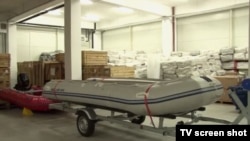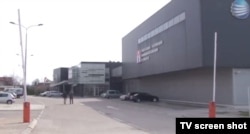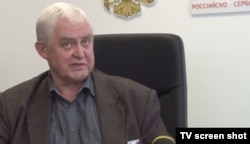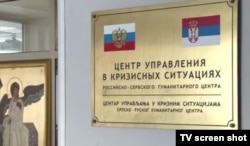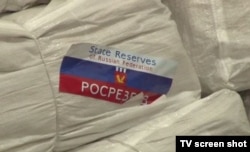Predrag Blagojevic, Ljudmila Cvetkovic and Iva Martinovic
Snap elections called by Serbian Prime Minister Aleksandar Vucic will stall a long-awaited agreement between Russia and Serbia on the status of the four-year-old Russian-humanitarian operations now based near Nis Airport.
Although Serbian President Tomislav Nikolic wanted to sign the agreement when Russian Prime Minister Dmitri Medvedev visits Serbia this spring, the upcoming snap elections will prevent that.
First, elections are required, then the formation of a new Parliament and new Government and then the new government will get a chance to debate the Center in Nis, said Nikolic.
Nikolic, when he signed an agreement between Serbia and NATO, said he thought a similar agreement with Russia providing the same conditions for the humanitarian center would “represent a good balance that would practically confirm military neutrality of Serbia”.
Vucic, however, did not mention such an agreement in an interview with a TV outlet: “We did not sign for any American center here. And we are yet to discuss anything about the Russian Center with Russians.”
The Serbian Parliament ratified the agreement between Serbia and NATO, called a Support and Procurement Organization (NSPO) on February 12 on logistics support.
The agreement includes freedom of movement and diplomatic immunity for all NATO members in Serbia, confidential data and equipment exchange; that NSPO and its funds, revenues and other assets would be excluded from taxation and the customs system, aside from payment of public utilities.
NSPO members, including their vehicles, would have a right of free passage and access everywhere in Serbia.
Milovan Drecun, state MP from Nikolic and Vucic’s Progressive Party, said he agreed that it would be necessary to regulate the status and immunity of people working in the Humanitarian Center, but it should not be compared to the agreement with NATO.
“NATO staff, when moving on Serbian territory, will be armed and have military equipment. That cannot be compared to the Center that is of a humanitarian character. So, the Russian-Serbian Humanitarian Center is a civilian structure. In my opinion, the most important thing in this agreement is that it is going to regulate certain financial issues, and the Center will not have to pay custom duties on the equipment that is going to be shipped to the Center from the Russian Federation,” he said
As for a Russian view, Maria Zaharova, the country’s spokesperson for the Ministry of Foreign Affairs said that Russia believes that Belgrade would stick to neutrality and that Russia “is ready for dialogue with Serbia with regard to signing the agreement on the Russian-Serbian Humanitarian Center in Nis.
It is exclusively a civilian structure, and speculations of its alleged military, and even in some case spy-like character, are malicious fabrications.”
Speculation about darker motives than rescue work has swirled around the facility since it was established in 2012 and it was formally opened in 2014.
Situated several hundred meters from Nis Airport, and nearly that far from the highway, the Russian-Serbian Humanitarian Center is a Russian base that officials say is designed to offer assistance in emergency situations and natural disasters.
Several years later and several disasters later, suspicions remain that it offers a Russian foothold in Serbia and an installation that could quickly be turned into a military base.
But Vjaceslav Vlasenko, co-manager of the center who has worked in the Russian Ministry of Emergency Situations dismissed any idea of military presence:
“I came here to work as a civilian under a contract. In accordance with the Russian laws, there are no military personnel here. Even the rescuers who come are members of a rescue squad in Russia. There are 100 percent not soldiers.”
At the time of his interview in early March, some Belgrade media were speculating that Vucic would not sign an agreement with Russia along the lines of the one signed with NATO.
Vlasenko said then: “I do not want to criticize Serbia, to comment on Vucic’s statements and so on, Serbian leadership is working in accordance with the interests of its people. However, I will say why it is important to us to sign the agreement with the Center."
He continued: "Put it this way: The Russian side is buying firefighting trucks; 20 of them were purchased last year. The price of each one of them includes (Serbian) taxes. If the agreement had been signed, Russia would have been able to give to Serbia 25 trucks instead of 20. The same refers to any equipment assigned here, either generators, Nivas, rescue equipment – we pay taxes on all the equipment.”
Bosko Jaksic, a Belgrade-based foreign policy analyst, said:
“I … am not a promoter of that neutrality and I see it as anachronistic …, [but] I can still agree that is should be supported as an attempt to balance between the East and the West. But giving the same status to humanitarian workers as to soldiers on a mission… are two qualitatively different things.”
Drecun also heads the Serbian Delegation to the Parliamentary Assembly of the Collective Security Treaty Organization (ODKB), a military alliance led by Russia with Serbia as an observer as of 2013. He said that one cannot talk of a balancing policy when Serbia has “clearly stated its strategic foreign policy priority, and that is the EU membership and then cooperation with other countries and organizations”.
He said: “Considering the fact that a multipolar world is being created with new forces rising, where new associations are formed and new regional systems, collectively – security systems such as ODKB led by the Russian Federation – it is necessary to develop cooperation with those countries and those centers. In that sense, Serbia wants to have a strategic partnership with the Russian Federation, mainly because of the economic reasons. We also have bilateral cooperation on defense and security levels with the Russian Federation, but it is far below the level of our cooperation with NATO…”
Vlasenko dismissed as “silly” claims that Washington feared Russian influence spreading and that the center could be turned into a military base :
“In order to move away from those unfounded accusations, the Center … opened our doors, we allowed all the journalists, nongovernmental organizations and all civilian organizations to come and visit us anytime, see and learn about the Center’s activities and equipment that is here. People from the UN, the UNCHR, the EU representatives and many other organizations came here and could see what the Center is doing.”
During a tour of the facility organized for journalists, RFE/RL’s reporter did not notice anything establishing any military purpose.
The facility of the Russian-Serbian Humanitarian Center, when he toured it, was located in a building built 10 years ago as an office for “Pakom” company, which dealt in the computer trade. Since then, the company still maintains some space but rents most of the building. What was in view were several offices and a large storage space.
The storage contained a significant number of tents, sleeping bags, beds, inflatable boats, several solid fuel furnaces, and several very powerful generators. Also, there was a van and one ‘Lada Niva’.
No other equipment was in evidence in the building of several floors on a rather small surface with a parking lot for 30-40 cars. It was fenced with common gates that seemed open always, with no guard or security check.
The main task of the Humanitarian Center, which is under joint Russian-Serbian administration, is to react in emergencies, says Vlasenko, and the center’s website says it was founded with a goal to react in emergencies and perform tasks including demining, fighting wildfires, performing rescue missions during floods.
More recently, it has assisted in setting up refugee camps for Syrians fleeing the war in their country.
Vlasenko points to activities performed from the center:
“…When big wildfires spread throughout Serbia in 2013,. Russia reacted immediately and sent two airplanes and one firefighting helicopter. And we did not put out wildfires only in Serbia, but also in other regions. That is the main task of this Center. You can have different emergencies; during winter you can have problems with heavy snow and ice rain, floods in spring and wildfires in summer.”
Other activities Vlasenko said the center was helpful in included an ice rain in Knjazevac, which led to a widespread outage in the municipality. The Humanitarian Center in Nis sent the generators and solid fuel furnaces. Also, during catastrophic floods in Serbia, assistance from Russia came in one day thanks to this Center.
They also participated in demining of leftover shells from the NATO intervention:
“European Commissioner for Humanitarian Aid and Crisis Management, Christos Stylianides told the Belgrade media during a signing of an agreement of Serbia’s participation in the EU Civilian Protection Mechanism last year, “Europe could never ask Serbia to close the Humanitarian Center in Nis, even though the Center could endanger the work of the Civilian Protection Mechanism”.
Jaksic concludes there is a high probability that employees of the Humanitarian Center in Nis will get diplomatic status, which will be a step away for Serbia from implementation of EU policy.
“We should keep in mind that [the EU] expects Serbia to join the regulatory mechanisms for emergency situations that already exist in Brussels. And that means not working in conjunction with the Russians. However, as long as it is keeping its neutrality and playing both ways, not just when it comes to this humanitarian segment, Serbia will find itself in a situation where it is going to be under pressure and criticism coming from both sides,” concludes Jaksic.




